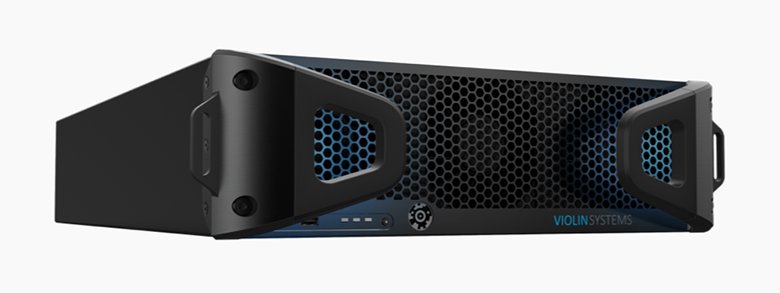
Kit Wai Chan - Fotolia
StorCentric buys flash storage pioneer Violin to fill gap
StorCentric's storage portfolio added an NVMe-based midrange option to its Nexsan and Vexata lines with the acquisition of beleaguered all-flash array pioneer Violin Systems.
StorCentric orchestrated its fifth acquisition in around two years and scooped up beleaguered all-flash array pioneer Violin Systems to fill what it perceives as a midrange gap in its expanding storage portfolio.
StorCentric, based in Sunnyvale, Calif., was incorporated in August 2018 with the merger of Drobo and Nexsan. The Violin acquisition continues a pattern of buying struggling storage companies with mature technology in its quest to address customers' data management problems.
StorCentric's acquisition of Violin for an undisclosed sum of cash and equity came just over a year after the trailblazing all-flash storage array vendor shut down its San Jose headquarters, eliminated its California-based executive team and appointed Todd Oseth as its third CEO in less than three years.
Flash storage acquisition surprises analysts
The Violin acquisition puzzled some storage analysts. StorCentric already had brought a higher performance NVMe-based flash array into the fold with its purchase of Vexata, another floundering vendor, in July 2019 during a mini buying spree that added backup software specialist Retrospect just a week earlier.
Marc Staimer, founder and president of Dragon Slayer Consulting, said he was surprised because Violin trailed the market in key capabilities such as a scale-out architecture and performance density in comparison to newer flash storage players such as Pavilion, Fungible and even Vexata.
But StorCentric CEO Mihir Shah said Violin would give his company an affordable midrange option that supports low-latency NVMe and fills a flash storage portfolio gap between the less costly, lower-performance Nexsan systems and the more expensive, high-end Vexata products.
"That's why you see a lot of these small companies not do well, because they don't have something to fall back on," Shah said, "if there's an objection with the customer."

Use cases for StorCentric flash storage
StorCentric CTO Surya Varanasi, who co-founded Vexata, sees the main use cases for Violin arrays as databases, virtualization and virtual desktop infrastructure. He said Vexata chased high-end customers, including credit companies and hedge funds, and focused on analytics, AI, machine learning and Oracle Rack workloads.
At the low end, StorCentric's Nexsan line gives customers a choice of SAS-based solid-state drives with triple-level cell (TLC) or dense quad-level (QLC) 3D NAND flash, hard-disk drives, or a hybrid combination of the two. Varanasi said the QLC flash-equipped arrays are a good fit for backups, archives and other high-capacity use cases.
"We're definitely going after different markets with these products," Varanasi said. "And the thing we're really excited about is the huge cross-sell opportunity that we have, because many of the customers that have bought one of these brands have a need for the other one, but we weren't able to quite cover that ground."
StorCentric plans to keep the Violin brand, as it did with Nexsan, Vexata, Drobo and Retrospect products. Varanasi said the company would sell the Violin software bundled with hardware but eventually evolve to a software-only model, because engineers designed the product to run on commodity servers. Channel partners could determine how customers get the product, he said.
"Some channel partners are very comfortable selling bundled hardware and software solutions, so for them, we'll keep it that way," Varanasi said. "But there are those who just want the software itself, and they can put it on the hardware of their choice, and we'll enable them to consume it that way."
Violin storage software
Violin's acquisition of X-IO technologies added capabilities such as deduplication and proactive monitoring to the enterprise storage features the product already had. StorCentric plans to integrate some technology between its flash product lines in the future, according to Varanasi. He cited a past example when the company used its Vexata flash expertise to build the QLC-based Nexsan E-Series systems that came out earlier this year.
Varanasi claimed that the Violin line would compete against midrange systems from vendors such as Dell EMC and Pure Storage on price, performance and features. But IDC research vice president Eric Burgener said Violin is "just not competitive" against the NVMe-based versions of Dell EMC's PowerMax, IBM's latest flash arrays and Pure's FlashArray//X.
"Why you would buy a system from StorCentric as opposed to from one of the majors? The only reason in my mind is price, because they're not going to get better tech support," Burgener said.
Burgener said he could envision StorCentric adding some of Violin's data services to the Vexata product line that is "designed as a pure performance play with no software."
In addition to its Drobo, Nexsan, Retrospect, Violin and Vexata products, StorCentric also sells a Data Mobility Suite that it introduced this week. The tool is designed to enable customers to migrate, replicate and manage data across heterogeneous cloud or on-premises environments.
Violin experienced highs and lows
Violin rode an early flash wave to an initial public offering in 2013, but struggled financially after established storage vendors began selling flash arrays equipped with more enterprise storage capabilities. Violin filed for Chapter 11 bankruptcy in late 2016. Private equity firm Quantum Partners acquired Violin's assets in 2017.
Shah said StorCentric plans to keep the "very good team" of about 35 Violin employees that includes engineering, sales and marketing staff. Violin employed 400 in its heyday but was down to about 25 direct staffers by October 2019, after Oseth shifted from chief operating officer to CEO at the company.
At that time, Oseth said Violin had about 250 active customers, including some large banks requiring high performance. StorCentric said Oseth indicated Violin currently has 900 customers.




